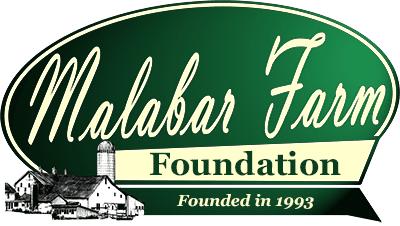Crop Rotations & Pastures
Malabar Farm sustainable agriculture, crops, and animals at the farm. Preserving the legacy of Louis Bromfield and his dedication to eco-friendly farming.
Crop Rotations
Soy Beans:
Soy varies in growth and habit. The height of the plant varies from below 20 cm (7.9 in) up to 2 metres (6.6 ft).
The pods, stems, and leaves are covered with fine brown or gray hairs. The leaves are trifoliolate, having three to four leaflets per leaf, and the leaflets are 6–15 cm (2.4–5.9 in) long and 2–7 cm (0.79–2.8 in) broad. The leaves fall before the seeds are mature. The inconspicuous, self-fertile flowers are borne in the axil of the leaf and are white, pink or purple.
The fruit is a hairy pod that grows in clusters of three to five, each pod is 3–8 cm long (1–3 in) and usually contains two to four (rarely more) seeds 5–11 mm in diameter.
Corn:
Maize stems superficially resemble bamboo canes, and the internodes can reach 44.5 centimeters (17.5 in). Maize has a distinct growth form; the lower leaves being like broad flags, generally 50–100 centimeters long and 5–10 centimeters wide (2–4 ft by 2–4 in); the stems are erect, conventionally 2–3 meters (7–10 ft) in height, with many nodes, casting off flag-leaves at every node. Under these leaves and close to the stem grow the ears. They grow about 3 millimeters a day.
The kernel of maize has a pericarp of the fruit fused with the seed coat, typical of the grasses, and the entire kernel is often referred to as the seed. The cob is close to a multiple fruit in structure, except that the individual fruits (the kernels) never fuse into a single mass. The grains are about the size of peas and adhere in regular rows round a white pithy substance, which forms the ear. An ear contains from 200 to 400 kernels and is from 10–25 cm (4–10 in) in length.
Wheat:
Wheat (Triticum spp.) is a grass, originally from the Fertile Crescent region of the Near East, but now cultivated worldwide. In 2007 world production of wheat was 607 million tons, making it the third most-produced cereal after maize (784 million tons) and rice (651 million tons). Globally, wheat is the leading source of vegetable protein in human food, having a higher protein content than either maize (corn) or rice, the other major cereals. In terms of total production tonnages used for food, it is currently second to rice as the main human food crop, and ahead of maize, after allowing for maize’s more extensive use in animal feeds.
Oats:
The common oat (Avena sativa) is a species of cereal grain grown for its seed, which is known by the same name (usually in the plural, unlike other grains). While oats are suitable for human consumption as oatmeal and rolled oats, one of the most common uses is as livestock feed. Oats make up a part of the daily diet of horses, about 20% of daily intake or smaller, and are regularly fed to cattle as well. Oats are also used in some brands of dog food and chicken feed. Oat seeds are commonly marketed as cat grass to cat enthusiasts, since cats will readily harvest and eat tender young oat, wheat and some other grass sprouts.
Alfalfa:
Alfalfa (Medicago sativa) is a flowering plant in the pea family Fabaceae cultivated as an important forage crop in the US, Canada, Argentina, France, Australia, the Middle East, South Africa, and many other countries. It is known as lucerne in the UK, France, Australia, South Africa, and New Zealand, and known as lucerne grass in south Asia. It superficially resembles clover with clusters of small purple flowers.
Alfalfa is widely grown throughout the world as forage for cattle and is most often harvested as hay, but it can also be made into silage, grazed, or fed as greenchop. Alfalfa usually has the highest feeding value of all common hay crops. It is used less frequently as pasture. When grown on soils where it is well-adapted, alfalfa is often the highest yielding forage plant, but its primary benefit is the combination of high yield and high quality. Its primary use is as feed for high producing dairy cows—because of its high protein content and highly digestible fiber—and secondarily for beef cattle, horses, sheep, and goats. Humans also eat alfalfa sprouts in salads and sandwiches.
Like other legumes, its root nodules contain bacteria, Sinorhizobium meliloti, with the ability to fix nitrogen, producing a high-protein feed regardless of available nitrogen in the soil. Its nitrogen-fixing abilities (which increases soil nitrogen) and its use as an animal feed greatly improved agricultural efficiency.
Alfalfa can be sown in spring or fall and does best on well-drained soils with a neutral pH of 6.8 – 7.5. Alfalfa requires sustained levels of potassium and phosphorus to grow well. Soils low in fertility should be fertilized with manure or a chemical fertilizer, but correction of pH is particularly important. Usually a seeding rate of 13 – 20 kg/hectare (12 – 25 lb/acre) is recommended, with differences based upon region, soil type, and seeding method. A nurse crop is sometimes used, particularly for spring plantings, to reduce weed problems and soil erosion, but can lead to competition for light, water and nutrients.
In most climates, alfalfa is cut three to four times a year, but it can be harvested up to 12 times per year in Arizona and southern California. Total yields are typically around 8 tonnes per hectare (4 short tons per acre) in temperate environments, but yields have been recorded up to 20 t/ha (16 short tons per acre). Yields vary with region, weather, and the crop’s stage of maturity when cut. Later cuttings improve yield, but with reduced nutritional content.
